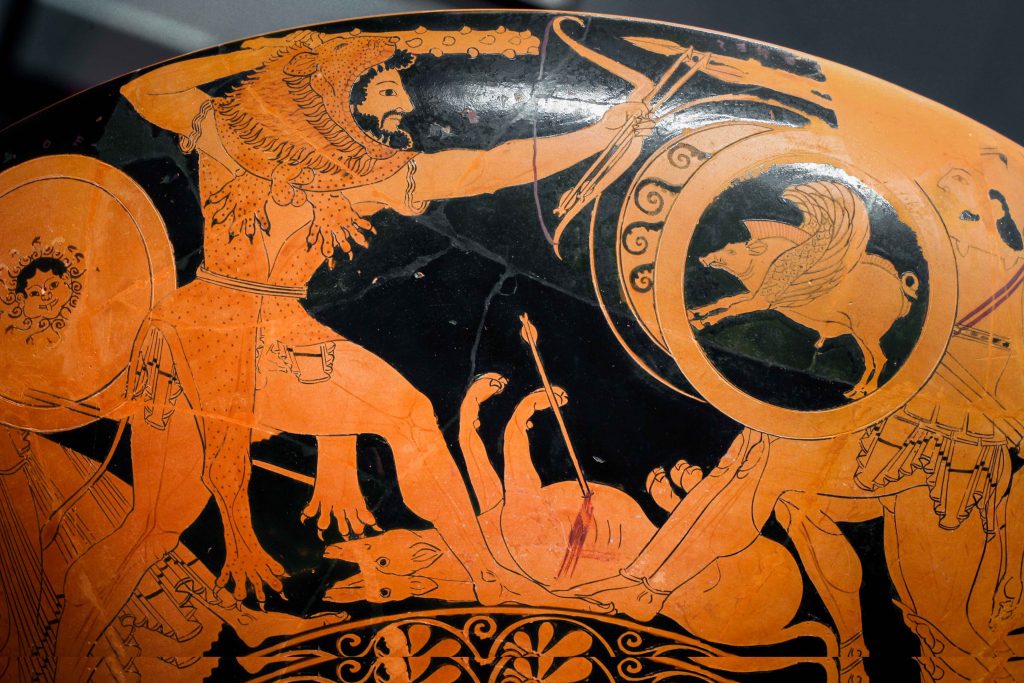
[Geryon addresses Menoites] “Do not with talk of chilling death try to frighten my manly heart, nor (beg me) … for if I am by birth immortal and ageless, so that I shall share in life on Olympos, then it is better (to endure) the reproaches … and … to watch my cattle being driven off far from my stalls; but if, my friend, I must indeed reach hateful old age and spend my life among short-lived mortals far from the blessed gods, then it is much nobler for me to suffer what is fated than to avoid death and shower disgrace on my dear children and all my race hereafter—I am Khrysaor’s son.”
Stesichorus, Geryoneis Fragment S11[1]
This seems to be the key point in the lost Geryoneis by the poet Stesichorus, whether our hero would prove a deathless god or a short-lived mortal in the fight to come with Hēraklēs. His father, the Giant Chrysaor, proved mortal and fell to earth like a lightning bolt loosed by Zeus.[2] That is his father’s shield in the image above.[3] His grandmother Medusa also proved herself mortal when she lost her head.[4] But his Uncle Pegasus lived upon Olympus[5] and his mother was a divine Oceanide[6].
Aaron Atsma identifies the Menoites addressed above as “Menoetius, brother of the Titans Atlas and Prometheus, who was cast into Erebos by Zeus.”[7] presumably now serving as Hades’ herdsman. Which ties in nicely with:
[Geryon] owned red kine, of which Eurytion was the herdsman and Orthus, the two-headed hound, begotten by Typhon on Echidna, was the watchdog. … However the dog, perceiving him, rushed at him; but he smote it with his club, and when the herdsman Eurytion came to the help of the dog, Hercules killed him also. But Menoetes, who was there pasturing the kine of Hades, reported to Geryon what had occurred…
Apollodorus 2.5.10, Sir James George Frazer[8]
And by the way Geryon’s guard-dog Orthos/Orthrus and Hades’ guard-dog Cerberus were littermates, according to Hesiod.[9]
Geryon is generally depicted as having three heads, and six arms on three torsos which unite at the hips. He reigns in the sunset lands of Erytheia, which:
… was originally conceived to be situated off the coast of Epirus, but afterwards it was identified with Gades or the Balearian islands, and was at all times believed to be in the distant west.
Dictionary of Greek and Roman Biography and Mythology[10]

Musée du Louvre MNC 495
The Tenth labor of Hēraklēs is to steal Geryon’s shambling[11] red oxen.[12] I will leave the outcome of the battle to the forums. But, keep in mind this might be the battle where…
…Hera, again, suffered when the mighty son of Amphitryon wounded her on the right breast with a three-barbed arrow, and nothing could assuage her pain. So, also, did huge Hādēs, [395] when this same man, the son of aegis-bearing Zeus, hit him with an arrow even at the gates of Hādēs, and hurt him badly. Then Hādēs went to the house of Zeus on great Olympus, angry and full of grief [akhos]; and the arrow [400] in his brawny shoulder caused him great anguish till Paieon healed him by spreading soothing herbs on the wound, for Hādēs was not of mortal mold”
Iliad 5, Sourcebook[13]
Notes
1 Stesichorus fragment, translated by D.A. Campbell, from Greek Lyric III. Cambridge MA.
Quoted on page “Geryon” at theoi.com
2 Hesiodic Theogony 979–983, Sourcebook Hesiodic Theogony : 1–115 Translated by Gregory Nagy, 116–1022 Translated by J. Banks and adapted by Gregory Nagy.
3 Aaron Atsma “Geryon” www.theoi.com
4 Hesiodic Theogony 274–281 “the Gorgons, who dwell beyond famous Okeanos, … Stheno, Euryale, and Medusa having-suffered sadly. The latter was mortal, … 280 From her too when, as the tale is, Perseus had cut off the head, up sprang huge Khrysaor …”
5 Hesiodic Theogony 280–288, Sourcebook “… up sprang huge Khrysaor and the steed Pegasus … And he indeed, winging his flight away, left Earth, the mother of flocks, 285 and came to the immortals; in Zeus’s house he dwells”
6 Hesiodic Theogony 287–288 “But Khrysaor, by union with Kallirhoe, daughter of famous Okeanos, begat three-headed Geryon.”
7 Aaron Atsma “Menoites” www.theoi.com
8 Apollodorus, The Library, with an English Translation by Sir James George Frazer, F.B.A., F.R.S. in 2 Volumes. Cambridge, MA, Harvard University Press; London, William Heinemann Ltd. 1921.
On Perseus
9 Hesiodic Theogony 309–313.
10 Dictionary of Greek and Roman Biography and Mythology quoted in entry for “Geryon” on theoi.com.
11 Described this way in Hesiodic Theogony 290.
12 Apollodorus Library 2.5.10.
For more on the “golden goblet” in which Herakles sailed, see the article “Hēraklēs and the Sea” on the Kosmos Society site.
13 Homeric Iliad Samuel Butler’s translation, revised by Timothy Power, Gregory Nagy, Soo-Young Kim, and Kelly McCray.
Texts retrieved July 2021.
Image credits
Image A: Euphronius Painter. Interior of Attic red figure kylix, c. 510–500 BCE Munich 2620
Photo: ArchaiOptix Creative Commons Attribution-Share Alike 4.0 International license.
Image B. Exekias potter: Side A, black-figure amphora. c 550–545 BCE. Louvre.
https://collections.louvre.fr/en/ark:/53355/cl010250647
Photo: © 2015 RMN-Grand Palais (musée du Louvre) / Stéphane Maréchalle
Images retrieved July 2021.
___
Bill Moulton is a long-time participant in the Kosmos Society.